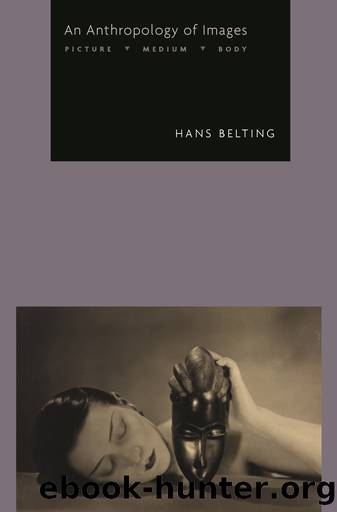An Anthropology of Images by Hans Belting;

Author:Hans Belting;
Language: eng
Format: epub
Publisher: Princeton University Press
Published: 2022-06-15T00:00:00+00:00
Fig. 4.8. Plaster mask of Nimaatre, Old Kingdom, Dynasty 6 (2350â2194 BCE), Egypt, Giza, Western Cemetery, Tomb G 2092+2093: pit (shaft) G 2092 a A, chamber. Gypsum plaster, 22.2 x 17 x 20 cm. Harvard UniversityâBoston Museum of Fine Arts Expedition 37.644. Museum of Fine Arts, Boston. Photo © 2011 Museum of Fine Arts, Boston. A similar lifelike quality characterizes the stone âreserve headsâ that were briefly in use during that same Fourth Dynasty period (Fig. 4.8): they could only have had a symbolic function, multiplying the stock of embodiments available to the deceased in the image repertoire of his tomb.52 This drive toward heightened verisimilitude waned when the notion of an afterlife resembling the temporal life of the living gave way to a new conception of the dead as souls dwelling in timelessness, who therefore no longer needed the accoutrements of an earthly life. An afterlife in the tomb was replaced by the idea of the Hereafter, and the notional change became manifest in a new death image.
The Egyptian conception of the image is most clearly demonstrated by a rite of animation known as the âmouth-opening ritual.â By New Kingdom times, the ceremony required that no less than seventy-five different actions and incantations be performed on the mummy, so that, as one incantation put it, âthe soul will remember what it has forgottenâ (Fig. 4.9). The custom had its origins in the Old Kingdom as a âstatue ritualâ that was conducted upon the completion of the statue but before it was set in place. It was through this animation ritual that the statue officially became a medium. What made a statue into an image, then, was not the manufacture of the physical statue, but rather a magical act that qualified it for embodiment. Only later was this ritual transferred from the statue to the mummy in order to secure there the interaction of the soul with the Hereafter.53 This chronology is important, because it attests once again to the analogy between the sculpture and the mummy.
Download
This site does not store any files on its server. We only index and link to content provided by other sites. Please contact the content providers to delete copyright contents if any and email us, we'll remove relevant links or contents immediately.
| Erotica | Human Figure |
| Landscapes & Seascapes | Plants & Animals |
| Portraits | Religious |
| Science Fiction & Fantasy | Women in Art |
The Art of Boudoir Photography: How to Create Stunning Photographs of Women by Christa Meola(18442)
Red Sparrow by Jason Matthews(5277)
Harry Potter 02 & The Chamber Of Secrets (Illustrated) by J.K. Rowling(3579)
In a Sunburned Country by Bill Bryson(3414)
Drawing Cutting Edge Anatomy by Christopher Hart(3361)
Figure Drawing for Artists by Steve Huston(3322)
Harry Potter and the Prisoner of Azkaban (Book 3) by J. K. Rowling(3190)
The Daily Stoic by Holiday Ryan & Hanselman Stephen(3156)
Japanese Design by Patricia J. Graham(3040)
The Roots of Romanticism (Second Edition) by Berlin Isaiah Hardy Henry Gray John(2837)
Make Comics Like the Pros by Greg Pak(2798)
Stacked Decks by The Rotenberg Collection(2734)
Harry Potter and the Deathly Hallows (7) by J.K. Rowling(2582)
Draw-A-Saurus by James Silvani(2570)
Tattoo Art by Doralba Picerno(2533)
On Photography by Susan Sontag(2516)
Churchill by Paul Johnson(2419)
Foreign Devils on the Silk Road: The Search for the Lost Treasures of Central Asia by Peter Hopkirk(2396)
The Daily Stoic by Ryan Holiday & Stephen Hanselman(2391)
